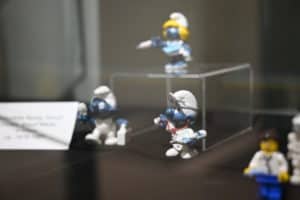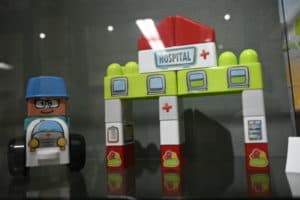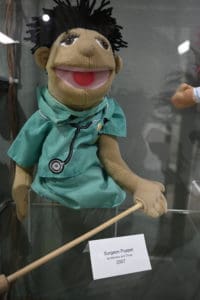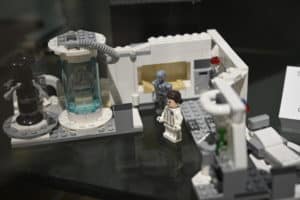View Larger Image

Different versions of the classic board game Operation are included in the exhibit.
Image by Spencer Watson
New Exhibit Features Toys That Inspire Health Professions
| For even the most accomplished surgeons, advanced nurses or brilliant researchers, their journey toward health sciences began somewhere, and a new campus exhibit explores the origin of many of those careers: toys and games.
The exhibit is located in the Central Building near the College of Medicine administrative offices
“There’s a board game there called Emergency. That was mine when I was a kid, and I remember playing it all the time,” said Tim Nutt, director of the UAMS Historical Research Center.
The center put together the exhibit, inspired by Nutt’s rummaging around in his attic and finding some old childhood toys, including a Fisher-Price hospital.
“There was a period when I thought I might be a firefighter or EMT. Obviously that didn’t happen, so the influence of these toys didn’t stick for me. But for others, I’m sure it did.”
That combination of curiosity and nostalgia fuels the exhibit, which features a wide variety of toys and games, largely from the second half of the 20th century, which all in some way relate to health sciences and professions.
For example, the classic board game Operation, which requires players to remove imagined ailments from a patient and buzzes obnoxiously at any error, is featured both in a modern and more classic form. The classic package includes an illustrated surgeon smoking as he operates, and Nutt said the obvious contrast is part of the point.
“Times have changed, and that was something we wanted to show, how toys have changed from back in the ‘40s and ‘50s and ‘60s,” he said.
One big aspect of change during that time was gender roles in medicine, and these are reflected in many ways, including through the evolution of Barbie dolls, also part of the exhibit.
Barbie debuted in 1959 and would be a nurse by 1961. Surgeon Barbie became available in 1973, “which was somewhat groundbreaking.” The ‘80s would see career additions of doctor and veterinarian.
“It’s interesting to look at that history,” said Nutt.
Speaking of Barbie, the exhibit contrasts the packaging of toys and their intended audience, historically separated by gender and rife with stereotypes.
“We wanted to include the gendered aspect of toys and how toys were marketed specifically for girls or specifically for boys,” said Nutt. “For the most part, you have the females always wearing pink, the boys always wearing blue. The females were always going to be nurses, the boys would always be doctors.”
There are exceptions, and those are featured, too. Diversity was an important factor in putting the exhibit together. The effort includes non-gender specific examples, as well as toys featuring representations of people from different racial and ethnic backgrounds.
With toys being a tool of the imagination, the exhibit explores interpretations of medicine in fiction, from tiny blue Smurf characters in medical garb to Treasure Tolls dressed for surgery, to future medicine in science fiction – an idea Nutt said may lead to an entire exhibit by itself. The exhibit includes medical-related toys from both Star Trek and Star Wars.
Ultimately, the new exhibit is meant to provide smiles at a time when they have been in short supply – or, more accurately, hidden by face masks because of the COVID-19 pandemic.

Characters from the Smurfs, an animated cartoon for children, dressed in medical attire.Spencer Watson
“Everyone is tired of the pandemic, and we wanted to give people something to laugh about or bring back childhood memories. We wanted to cheer people up. We also wanted a fun exhibit. Learning can be fun! It doesn’t have to be all facts and numbers.”
Nutt said his favorite item is a handheld puppet dressed as a surgeon that includes a stick to control one arm, essentially allowing the puppeteer to mimic surgery. A close second is a Play-Doh set featuring dentistry.
“It’s a face in a head that opens up, so you can create teeth and fill the cavities with Play-Doh. It’s really cool. I’d never seen anything like that before,” he said.
The exhibit was supported by the Society for the History of Medicine and Health Professions, which donated $500. Items were either donated, given on loan, or purchased via eBay, Amazon or at garage sales or thrift stores. The acquisition process is ongoing, and the exhibit is still growing.
“We are still looking for donations or loans. People don’t necessarily have to give us the toys. We’d love to have them on loan,” Nutt said. “And if someone has a photo of themselves playing with a certain toy, that would be even better. We can scan the photo, put the photo next to the toy in the exhibit and provide some background and a memory.”
When visitor restrictions are finally lifted, Nutt said, he hopes to host a lecture or symposium about toys inspiring career ambitions in health sciences. Anyone with such a story or potential addition to the exhibit is encouraged to contact the Historical Research Center at tgnutt@uams.edu or (501) 686-6735.
“I do hope our doctors and nurses and other medical professionals contact us and say something like, ‘I had an Operation game as a kid, and that really sparked my interest in being a doctor. I practiced with it every day and now I’m one of the finest surgeons in the U.S., and I owe it all to Parker Brothers!’”


